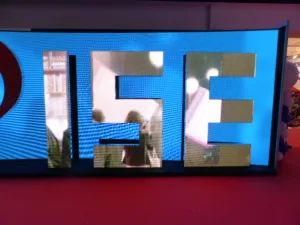ISE 2016 ran from the 9th – 12th February in Amsterdam’s RAI exhibition centre: the first four-day show in in the event’s history. Although we heard differing reasons for the change (too much to see, health risk, Amsterdam becoming overcrowded…), we can say that it was definitely a positive one.
Registered attendees rose 10.7% YoY, to 65,686 – making ISE officially the world’s largest AV and systems integration trade show (at least, according to the organisers). Exhibitor numbers, meanwhile, were above 1,100, with press from 40 different countries.
ISE 2017 is already bigger than the 2016 show, with 47,131m² of exhibition space sold – 102% of the total space of this year’s edition, and 95% of the total space available. A new hall will be added next year, as well as a new hall numbering system.
Key Topics
As at Infocomm 2015, small pitch LED was one of the key topics at the display. The displays look more and more impressive and you can see how the LED makers are intending to attack video walls – Leyard (Planar) was showing a module that is sized at just smaller than a 55″ video wall display and clearly designed to simply replace a narrow bezel LCD.
Cost remains an issue, but new technology was on display from Deepsky that delivers very high brightness and uses microLED. That’s going to be significant in the future and it will be worth watching out for future developments from Silicon Core. There’s a fight on to offer front service to LED modules and to extend applications into control rooms and other areas.
Touch is a big topic. It was clear at the show that procap is going to make a big dent in the large screen touch market, and we see companies such as Baanto and others that rely on optical and infrared needing to find areas where they can do well. As for solutions for large procap, it seems to be coming down to a battle between Cima Nanotech and a variety of metal mesh solutions. Collaboration software and networking is getting better and better to support the big screens.
High brightness flat panels are being seen more widely, but 2,500 cd/m² is around the top of the mainstream, leaving brightness above to companies such as Dynascan.
The projector makers have shifted strongly to laser phosphor, which is clearly the future for the higher end of the mainstream for the time being. LED is likely to be the winner at lower brightness. The battle between Epson/3DLP and TI was more analytical this time, but just as fierce. In the end, the noise made by Epson will push makers to make better products, which will be good for users.
AV over IP is a long term trend, and after moderating a couple of panels on the subject, our Managing Editor was convinced by the potential of the Aptovision technology which can transmit uncompressed FullHD over “commodity” 10GB switches. On the other hand, it needs the firm’s chips at each end, and others, such as Barco Silex are looking at standards-based approaches.
Anyway, as always, this was a good show with lots of great products to see.

